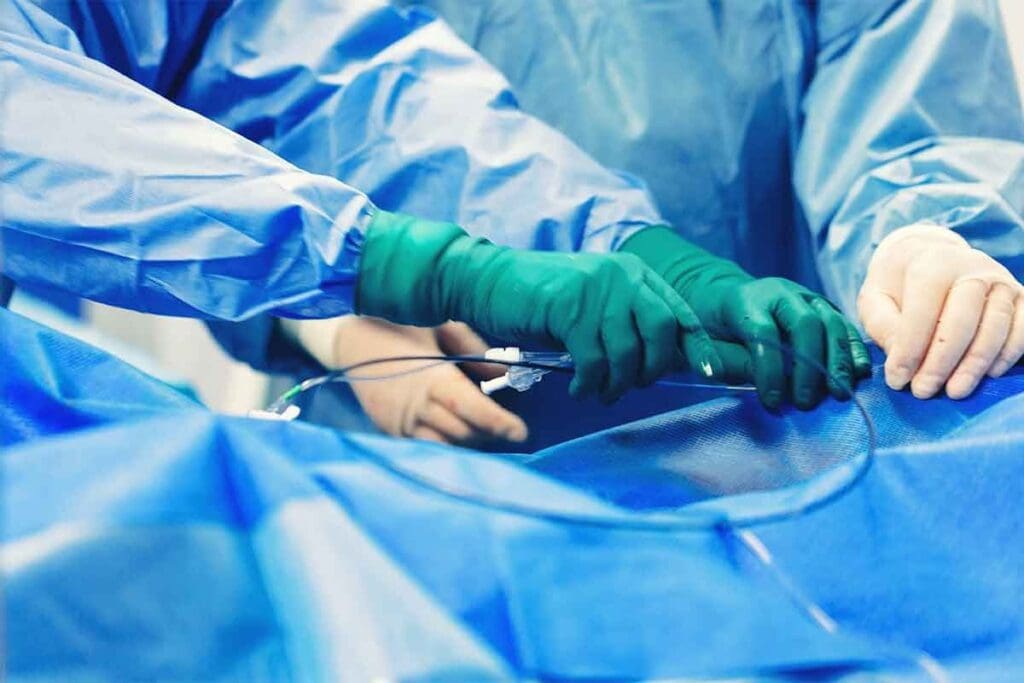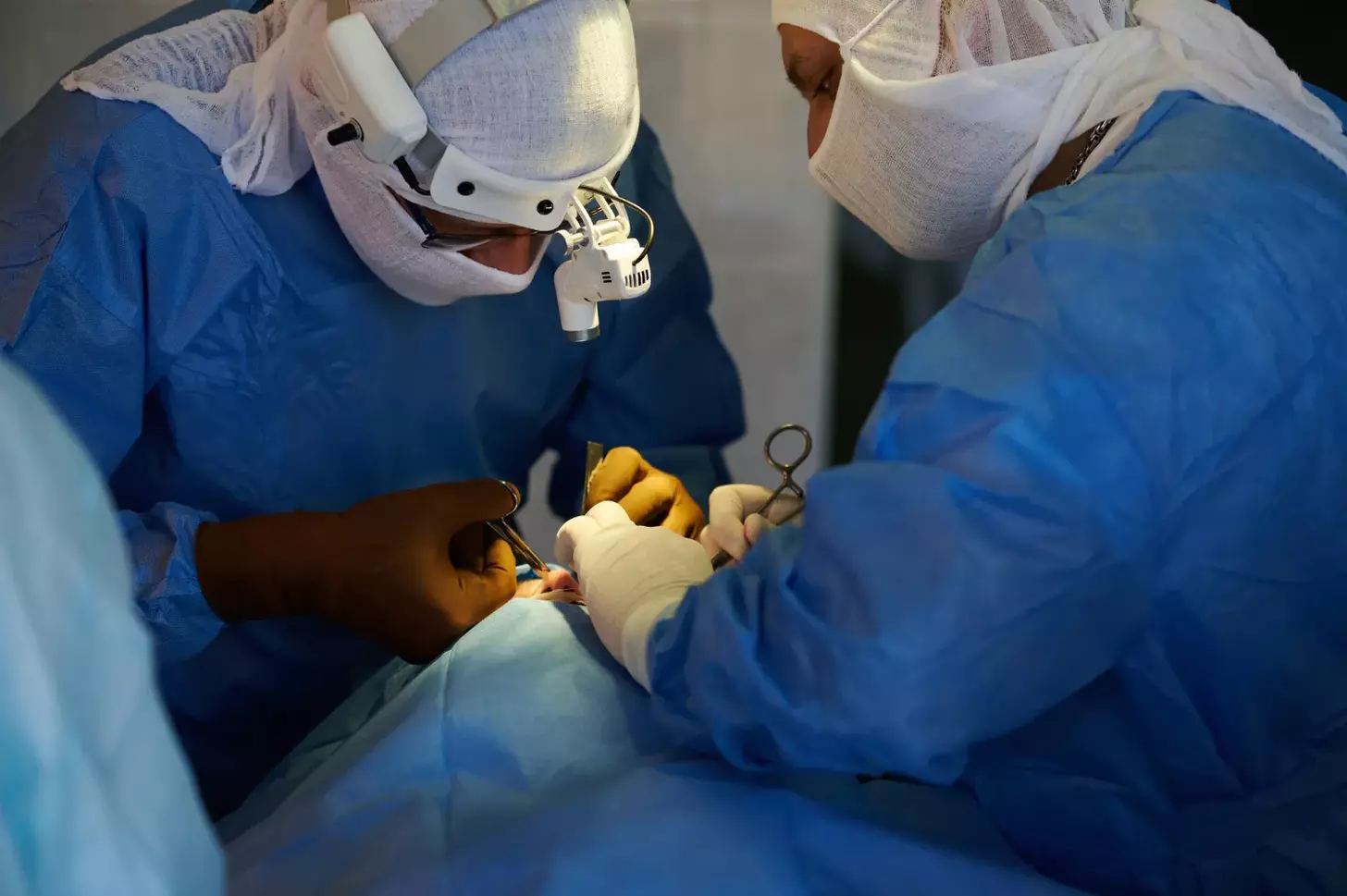Last Updated on November 26, 2025 by Bilal Hasdemir

It’s important for both patients and doctors to understand how stents help with heart problems. A Triple A stent is used to fix a serious condition called abdominal aortic aneurysms (AAA). This condition can be very dangerous.
New stent technology has made treating heart disease better. Angioplasty and stent placement are now key treatments. Every year, over two million stents are put in hearts around the world. This shows how vital this treatment is.
Key Takeaways
- Triple A stents are used to treat abdominal aortic aneurysms.
- Stent grafts have evolved to accommodate various patient anatomies.
- Angioplasty with stenting is a key therapy for coronary artery disease.
- Over two million coronary stents are implanted worldwide annually.
- Advances in stent technology have reduced recovery times.
What Are Triple A Stents and Abdominal Aortic Aneurysms

Triple A stent grafts have changed how we treat abdominal aortic aneurysms. They offer a new way to fix this serious problem without big surgery. An abdominal aortic aneurysm is when the main blood vessel in the abdomen gets too big.
Definition and Purpose of AAA Stent Grafts
AAA stent grafts are endovascular devices that keep the aneurysm from getting bigger. They stop it from bursting. These stents are made of strong materials like Gore-Tex or Dacron and have a metal frame.
- They go in through small cuts in the groin.
- They are guided to the aneurysm with imaging.
- They are then put in place to block the aneurysm.
How Abdominal Aortic Aneurysms Develop
AAAs grow because of atherosclerosis, genes, and lifestyle. Atherosclerosis makes the aortic wall weak. This is because of plaque buildup in the arteries.
Risk Factors and Detection Methods
Things that increase your risk of getting an AAA include:
- Age: Most people with AAAs are over 65.
- Smoking: It’s a big risk factor.
- Family History: If a first-degree relative has an AAA, you’re at higher risk.
Doctors use ultrasound screening to find AAAs in people at risk. Finding it early is key to treating it well.
The Evolution of Stent Technology for Vascular Repair
Stent technology has greatly improved vascular repair outcomes. From its early days to today’s advanced designs, there have been many breakthroughs.
Historical Development of Stent Designs
The first stents were made from stainless steel. They worked well but had some drawbacks. Later, cobalt-chromium and platinum-chromium alloys became popular, leading to better performance and safety.
A study on coronary artery stents highlights the importance of design evolution. This evolution has greatly improved patient results coronary artery stents.
Stent designs have also become more advanced. Now, they have drug-eluting coatings to lower restenosis risk. This has made stenting procedures more effective.
Materials and Engineering Advancements
The move to better materials has been key. Cobalt-chromium and platinum-chromium alloys are stronger, more flexible, and clearer. They are perfect for making stents.
| Material | Characteristics | Benefits |
| Stainless Steel | Strong, but less flexible | Early stent technology |
| Cobalt-Chromium Alloys | High strength, good flexibility | Improved stent performance |
| Platinum-Chromium Alloys | Excellent radiopacity, flexible | Enhanced visibility during procedures |
Patient-Specific Customization Options
Today, stents can be made to fit each patient’s needs. This personalization aims to improve outcomes by ensuring a better fit and reducing complications.
The future of stent technology is bright. Ongoing research aims to make stents even better. As technology advances, stents will play a bigger role in vascular repair.
Coronary Stents: Structure and Function
Coronary stents are key in treating blocked arteries. They help prevent heart attacks and improve life quality. These small, mesh-like tubes keep arteries open, ensuring blood flows to the heart.
Stents are made to be flexible and strong. They can handle the heart’s stress. They’re made from materials like stainless steel and cobalt-chromium, which are strong and safe for the body.
Types of Cardiac Stents Available
There are many cardiac stents, each for different needs. The main types are:
- Bare Metal Stents (BMS)
- Drug-Eluting Stents (DES)
- Bioresorbable Vascular Scaffolds (BVS)
Each stent type has its own benefits and uses. For example, drug-eluting stents release medicine to prevent artery narrowing.
How Coronary Stents Treat Artery Blockages
Stents keep arteries open to treat blockages. The process is:
- Accessing the blocked artery through a catheter
- Inflating a balloon to widen the artery (angioplasty)
- Deploying the stent to keep the artery open
This method is quick and less invasive than surgery. It has changed how we treat heart disease.
Bare Metal vs. Drug-Eluting Stents
Choosing between bare metal and drug-eluting stents depends on several factors. These include the patient’s health, artery size, and if they have diabetes. Here’s a comparison:
| Feature | Bare Metal Stents | Drug-Eluting Stents |
| Restenosis Risk | Higher | Lower |
| Medication Release | No | Yes |
| Duration of Antiplatelet Therapy | Shorter (1 month) | Longer (6-12 months) |
Studies show drug-eluting stents reduce artery narrowing more than bare-metal stents. They are often the better choice for many patients.
“The introduction of drug-eluting stents has been a game-changer in interventional cardiology, providing a more effective solution for coronary artery disease.”
In summary, coronary stents are essential in managing heart disease. Knowing about the different stents and their uses is important for both doctors and patients.
The Complete Angioplasty Procedure Explained
The angioplasty procedure is key in treating heart disease. It’s a precise method to get blood flowing again. This technique is vital for managing heart artery blockages.
Pre-Procedure Preparation and Assessment
Before angioplasty, patients get a detailed check-up. They review their health history, current meds, and test results like angiograms.
Preparation Steps:
- Patients learn about the procedure and its risks.
- They discuss their medical history and current health.
- They talk about what to expect after the procedure.
Step-by-Step Angioplasty Process
The angioplasty process has several steps:
- Local anesthesia is given to numb the area.
- A catheter with a balloon is inserted through an artery.
- The catheter is guided to the blocked artery using imaging.
- The balloon is inflated to widen the artery, which may be done several times.
- A stent might be placed to keep the artery open.
Balloon Angioplasty vs. Stent Placement
Balloon angioplasty and stent placement are used together. Balloon angioplasty widens the artery with a balloon. Stent placement uses a mesh tube to keep the artery open.
| Procedure | Purpose | Benefits |
| Balloon Angioplasty | Widen narrowed arteries | Quick restoration of blood flow |
| Stent Placement | Keep arteries open after angioplasty | Reduces risk of artery re-narrowing |
A leading cardiologist says, “Using balloon angioplasty and stent placement has greatly improved patient outcomes.”
“Drug-eluting stents have been a major breakthrough. They’ve cut down on restenosis and improved long-term artery openness.”
Heart Catheterization: The Gateway to Stent Placement
Heart catheterization is a key tool for diagnosing heart diseases. It helps doctors see the heart’s arteries and decide if a stent is needed. This step is important before placing a stent.
The Heart Cath Procedure in Detail
The heart cath procedure starts with a thin, flexible tube called a catheter. It’s inserted through an artery in the leg or arm and guided to the heart. A contrast dye is then used to see the arteries on an X-ray.
This lets doctors spot any blockages or problems. The whole process takes about 30 minutes to an hour. It can take longer if the case is more complex.
Diagnostic vs. Interventional Catheterization
Heart catheterization can be for two main reasons. It can help diagnose heart conditions or perform treatments like stent placement. The choice depends on what the doctor needs to do.
Key differences between diagnostic and interventional catheterization:
- Diagnostic catheterization is mainly for looking at the arteries and finding problems.
- Interventional catheterization is for treatments like stent placement.
- Both can be done in one session.
Imaging Technologies Used During Catheterization
Several imaging tools are used during heart catheterization. They help guide the procedure and ensure stents are placed correctly. These include:
- X-ray Fluoroscopy: Gives real-time X-ray images to help guide the catheter.
- Angiography: Uses dye to show the arteries and find blockages.
- Intravascular Ultrasound (IVUS): Provides detailed images of the arteries’ inside, helping with stent placement.
These tools work together to give a clear view of the heart’s arteries. This helps doctors perform precise and effective treatments.
How a Heart Stent Is Actually Placed
Getting a heart stent right is key for a good outcome. The process has several important steps. Each step needs precision and care.
Navigating to the Blockage Site
The first step is finding the blockage. A thin, flexible tube called a catheter is used. It goes through an artery in the leg or arm.
The catheter is guided to the coronary artery with the blockage. Advanced imaging techniques like angiography help see the path. This ensures it gets to the right spot.
Stent Deployment Techniques
When the catheter reaches the blockage, the stent is deployed. A balloon angioplasty is used to widen the artery. The stent, on the balloon, expands to fit the artery.
Drug-eluting stents release medicine to stop the artery from narrowing again. The stent stays in the artery to keep it open and improve blood flow.
Confirming Proper Placement
After the stent is deployed, it’s checked to make sure it’s in the right place. Imaging techniques are used to confirm this. The procedure is a success if the stent is correctly placed and blood flow is restored.
Patients are watched for a short time to catch any immediate problems.
The process of placing a heart stent is complex. It needs skill and the latest technology. Understanding these steps helps patients see the care and expertise in their treatment.
Recovery and Aftercare Following Triple A Stent Procedures
The recovery after a triple A stent placement is very important. It needs careful attention and following specific guidelines. The goal is to make sure the stent works right and the patient gets better fully.
Hospital Stay Duration and Monitoring
Patients usually stay in the hospital for a while after a triple A stent procedure. How long they stay depends on the procedure’s complexity and their health. Medical staff watch them closely for any problems or bad reactions.
Close monitoring helps find and fix any early recovery issues. This includes checking vital signs, doing imaging tests, and checking how well the patient is doing.
Physical Activity Restrictions and Guidelines
Patients are told to not do too much physical activity after a triple A stent procedure. This helps avoid problems and keeps the stent in place. Specific guidelines for physical activity will be given by the healthcare team. It’s very important to follow these instructions.
Patients should not lift heavy things, bend, or do hard activities for a few weeks. They can start doing normal things again when their doctor says it’s okay.
Keeping Your Leg Straight: Necessity and Duration
Keeping the leg straight is a big part of aftercare for a triple A stent procedure. It helps avoid problems at the access site and makes sure the stent is in the right place. The healthcare team will tell you how long to keep your leg straight and why it’s important.
“Patients should be aware that keeping their leg straight is a critical component of their recovery. This helps to prevent bleeding and promotes healing at the access site.”
By following the aftercare guidelines, patients can help ensure a good outcome and a smooth recovery. It’s important to talk to the healthcare team about any questions or worries during the recovery time.
Global Statistics on Stent Procedures and Success Rates
Millions of stent procedures are done every year around the world. It’s important to know the stats behind these treatments. Stents help treat heart conditions, and knowing how well they work is key to improving health.
Annual Number of Stent Placements Worldwide
How many stents are placed each year shows how common heart diseases are. Over two million coronary stents are put in annually. This shows stents are a big part of treating heart disease.
Comparative Success Rates Between Procedure Types
Success rates for stent procedures depend on many things. This includes the type of stent, the patient, and how complex the procedure is. Drug-eluting stents work better than bare-metal ones because they lower the chance of blockages coming back.
| Procedure Type | Success Rate (%) | Restenosis Rate (%) |
| Bare-Metal Stents | 85-90 | 20-30 |
| Drug-Eluting Stents | 90-95 | 5-10 |
Cost-Effectiveness of Stenting vs. Traditional Surgery
Is stenting cheaper than surgery? This is a big question for health systems. Stenting might seem cheaper at first, but long-term costs can add up. Yet, studies show stenting can save money by cutting down on hospital stays and recovery times.
Key Findings:
- Stenting procedures have a high success rate, reducing the need for repeat interventions.
- The cost of stenting is generally lower than traditional bypass surgery.
- Drug-eluting stents, despite being more expensive, offer better long-term outcomes, potentially reducing overall healthcare costs.
Knowing the global stats on stent procedures is vital for doctors, policymakers, and patients. By looking at the data on stent use, success, and cost, we can make better choices for treating heart diseases.
Potential Complications and Risk Management
Knowing the risks of stent placement is key to managing them well. Stenting is safe for most people, but knowing the risks helps prevent and handle them if they happen.
Short-Term Complications to Be Aware Of
Right after stent placement, you might face bleeding at the site, allergic reactions to dye, or stent thrombosis. Stent thrombosis is a serious clot inside the stent that needs quick medical help.
Monitoring for these issues is vital after the procedure. Doctors watch patients closely for a few hours to spot any problems right away.
Long-Term Considerations for Stent Recipients
Long-term, you might face restenosis or stent durability issues. Restenosis is more likely with bare-metal stents than drug-eluting ones, which release medicine to stop cell growth.
To manage long-term risks, making lifestyle changes and taking medicines as directed is important. This includes diet, exercise, and antiplatelet therapy to stop clots.
Warning Signs That Require Immediate Medical Attention
It’s important to know when to seek urgent care. Signs like chest pain, shortness of breath, or severe bleeding mean you should go to the emergency room right away.
Also, watch for signs of infection at the catheter site, like redness, swelling, or fever. Spotting these symptoms early can help treat problems quickly.
Managing risks after stent placement requires medical care, lifestyle changes, and knowing the possible complications. Understanding these can greatly improve your health and life after the procedure.
Medications and Lifestyle Changes After Stent Placement
After getting a stent, patients must follow a set of medications and lifestyle changes. This is key to keep the artery open and keep the heart healthy.
Essential Antiplatelet and Other Medications
Dual antiplatelet therapy (DAPT) is very important after a stent is placed. It usually includes aspirin and a P2Y12 inhibitor like clopidogrel. How long you take DAPT depends on the stent type and your health risks.
Doctors might also give you medicines for high blood pressure, high cholesterol, or diabetes. Taking these medicines as directed is vital to avoid problems and keep the stent working well.
Dietary Recommendations for Heart Health
Eating well is very important after a stent. You should eat lots of fruits, vegetables, whole grains, and lean proteins. Try to eat less of foods high in saturated fats, trans fats, and cholesterol.
The DASH diet or Mediterranean diet are good choices for heart health. Drinking plenty of water and not eating too much salt are also good tips.
Exercise and Activity Guidelines for Recovery
It’s good to stay active to help your heart and overall health. At first, you might need to avoid hard work and heavy lifting. But, you can slowly get back to your usual activities and start doing aerobic exercises like walking or swimming.
Always listen to what your doctor says about exercise after a stent. Regular check-ups are important to see how you’re doing and make any needed changes to your lifestyle.
Conclusion: Advances in Stent Technology and Future Directions
The field of cardiovascular treatment has seen big steps forward with stent technology. This is true for treating abdominal aortic aneurysms and coronary artery disease. New stent designs, materials, and drug-eluting tech have made treatments better and less invasive.
Looking ahead, stent grafts and coronary stents will get even better. They will be safer, work better, and fit each patient’s needs more closely. Research and development will keep bringing new tech and methods to fight vascular diseases.
Stent technology has changed how we treat patients, making treatments more effective and less invasive. The future of stenting looks bright, with more innovations on the way. These advancements will keep improving care and results for patients.
FAQ
What is a triple A stent?
A triple A stent, also known as an abdominal aortic aneurysm (AAA) stent graft, is a medical device. It’s used to treat an abdominal aortic aneurysm. It’s a less invasive option compared to open surgery.
How do cardiac stents work?
Cardiac stents are small, mesh-like tubes. They are inserted into a blocked or narrowed coronary artery. This restores blood flow to the heart. They keep the artery open, improving circulation.
What is the difference between bare metal and drug-eluting stents?
Bare metal stents are made of metal and provide structural support. Drug-eluting stents release medication. This helps prevent the artery from re-narrowing.
Do I need to keep my leg straight after angioplasty with stenting?
Yes, keeping your leg straight is often recommended after angioplasty with stenting. It helps minimize the risk of bleeding or complications at the access site.
What is the recovery time for a heart stent procedure?
The recovery time for a heart stent procedure varies. Most people can return to normal activities in a few days to a week. Always follow the specific guidelines from your healthcare provider.
What are the possible complications of stent placement?
Possible complications include bleeding, infection, stent thrombosis, and restenosis. It’s important to know the warning signs and follow post-procedure care.
How is a heart stent put in?
A heart stent is inserted through a minimally invasive procedure called angioplasty. The stent is guided to the blocked area through a catheter. Once in place, it is expanded to keep the artery open.
What medications are required after stent placement?
After stent placement, patients take antiplatelet medications to prevent blood clots. Other medications may be prescribed to manage conditions like high blood pressure or high cholesterol.
Can I exercise after getting a stent?
Yes, exercise is important for recovery and heart health after getting a stent. Always follow the exercise guidelines from your healthcare provider.
How do I spell heart stent?
The correct spelling is “stent,” not “stint.” A heart stent is a medical device used to keep coronary arteries open.
What is the cost-effectiveness of stenting vs. traditional surgery?
Stenting is often seen as a cost-effective alternative to traditional surgery. It’s a minimally invasive procedure that can reduce hospital stay and recovery time.
What are the dietary recommendations after stent placement?
A heart-healthy diet is recommended after stent placement. It should include fruits, vegetables, whole grains, and lean protein. Avoid foods high in saturated fats, salt, and sugar.
References
- American College of Cardiology/American Heart Association. (2022). 2022 ACC/AHA guideline for the diagnosis and management of aortic disease. Circulation, 146(2), e334-e495. https://www.ahajournals.org/doi/10.1161/CIR.0000000000001106
- Brewster, D. C., Cronenwett, J. L., & Hallett, J. W. (2003). Guidelines for the treatment of abdominal aortic aneurysms. Journal of Vascular Surgery, 37(6), 1106-1117. https://www.sciencedirect.com/science/article/pii/S074152140300421X






